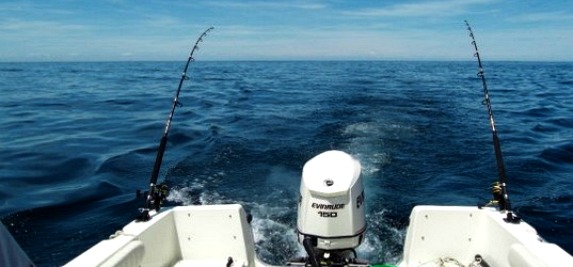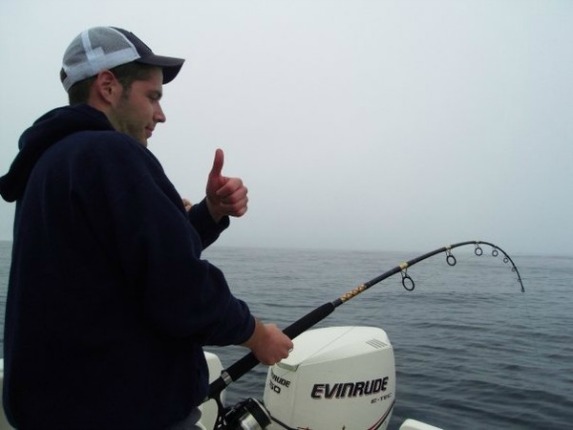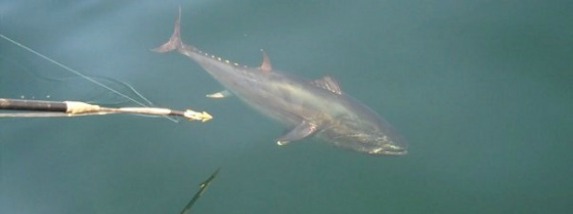Cape Cod tuna fishing is pretty unique in that it is 100% possible to hook up with a big bluefin tuna while fishing from a relatively modest boat. Plenty of tuna are caught each season from small center consoles or walk-around style boats typically used to pursue striped bass and bluefish. It is possible to catch Cape Cod tuna as large as 700 pounds from such small boats, as long as the weather cooperates.
In the most recent MFCC podcast I interviewed Captain Jay Ciancolo from Laura Jay Charters. Jay has been fishing for tuna his entire life, and he provided us with some very informative and useful tuna fishing advice. I think the most important tip he shared with us was to "keep it simple" and not let things get too complicated.
In this post I want to stick to the keeping it simple philosophy and share with you the technique I used to catch my first ever Cape Cod bluefin tuna. If you have never before caught a tuna on Cape Cod but want to during this season, then I highly recommend you give this super simple technique a shot.
Trolling For Tuna | A Super Simple Spread
First things first, if you do not have a tuna fishing license then I recommend you purchase one right now from NOAA. For most guys the recreational license is the one you want, but definitely read the fine print because the last thing you want to do is break a regulation. From what I've heard the fines can be substantial.
I have zero experience trolling big spreads for bluefin tuna. Running multiple conventional rods, outriggers and big spreader bars from my 21 foot boat is just not feasible. When I troll for tuna, I typically run 2 to 4 lines rigged with single hook baits 50-100 yards behind my boat.
This is as simple a spread as it gets.
Soft Plastics
For lures I really recommend 14 inch bubblegum Hogy soft plastics. I think these lures do an excellent job of imitating a variety of bait fish which tuna feed upon off Cape Cod. My tuna fishing buddy Jason Mazzola and I have had success using 10 inch pink and white Hogys, however the 14 inch bubblegum seems to be the most productive.
Rigging these lures is amazingly simple. All you need to do is thread a Gamakatsu 10/0 to 12/0 Live Bait Heavy Duty hook into the nose of the Hogy. Use some super glue on the shank of the hook to keep everything snug and in place. The Hogy should lay straight with the shank of the hook embedded in the nose of the Hogy, and the point of the hook protruding an inch back from the nose of the Hogy.
You want it to look like this:
We have had our best success trolling the Hogy between 4 and 6 mph, anywhere from 50 to 100 yards behind the boat. I have heard of guys having success trolling much slower, and even pausing their troll, so it can pay to experiment. If you can, try to get at least 2 and up to 4 Hogys skipping along the surface at one time.
The topwater bites are absolutely vicious and are my favorite part of the entire fight.
Equipment
Reel
If you have never caught a tuna before then I recommend purchasing a rod and reel that can be used in a variety of situations. The Fin Nor Offshore 9500 spinning reel is what I chose, because it works well for trolling Hogys, casting topwaters and even jigging for tuna. You can do a lot of different things with this reel and it is very reasonably priced.
Line & Leader
Load the reel up with as much 80 Pound Power Pro Depth-Hunter Metered Line as you can possibly pack onto it. You should be able to pack close to 500 yards onto the Fin Nor 9500. Double check that the line is packed super tight onto the reel spool. Major problems can occur if the line is not packed onto the reel spool as tight as humanly possible.
Fluorocarbon leader is a must. We've had success using a section of 5-8 feet of 100 pound Seagur flurocarbon. To connect the leader to the Power Pro I use a Slim Beauty knot. This works fine for trolling but I will admit that the Slim Beauty is not the most ideal solution for casting because the knot can get hung up in the rod guides. If you plan on casting to breaking tuna you might want to consider these wind-on leaders.
Rod
There's already a bunch of information available online with regards to the best spinning rods to use for tuna. If you need to purchase a spinning rod I recommend reading this article which will help you narrow down your choices.
Harpoon & Gaff
The most challenging part of catching a Cape Cod tuna is the end game. When the tuna is circling beneath your boat you best have a good harpoon and gaff at the ready. Landing a tuna without at least a gaff can be very challenging.
If you plan on releasing the tuna, then you certainly do not want to chuck a harpoon into its back. To get a good release I recommend following the lip gaff technique that the guys from Reel Deal Fishing Charters use at the end of this video.
I think the best gaffs in the business are from AFTCO. I don't think you want to skimp on the gaff so make sure you purchase a high quality one. The last thing you want is for the gaff to break as you lift a big tuna into the boat!
As far as harpoons go we have had good luck searching Craigslist for second hand harpoons at a discount. Having a harpoon on board can make the end game much, much easier if you intend on keeping the tuna. Sometimes the last 10 feet is most difficult to gain on the fish, and this is where throwing the harpoon can really make a difference.
In Conclusion
The June 1st start of the Cape Cod tuna fishing season will be upon us before we know it. I have my fingers crossed for a very productive 2014 tuna fishing season.
When the season does start be sure to check-in often here at the blog, especially on the membership side of MFCC for the latest tuna fishing information, reports, videos and articles.
Tight lines and take care,
Ryan







Great info! Im from michigan and this is my third year on the cape. I have a 22 wa cuddy and fish bass and blues all summer. I cant tell you how many times ive googled this type of article and found little to nothing! Now i know im def giving it a shot! Great read!
Thanks Tim! I am glad you found the information helpful. I like trying to keep things as simple as possible.
Keep me posted if myself, or the MFCC Community can help you at all during 2014. Stay in touch!
Ryan, I’m starting to like your articles more and more. They manage to stay descriptive and engaging without dragging on and on. I’ll be looking forward to the next one. Maybe you should start doing some articles for On The Water Magazine, it could help gain you some publicity. Just my $.02
Tight Lines
Thanks Chris, that is great to hear!
I’ve written a few articles for the good folks over at OTW, but maybe it’s time to write another one. Definitely great exposure.
Ryan, that was about the best article I have seen on simple Cape Cod tuna fishing from a smaller boat. My brother, Nick, and my Cape Cod Salties buddy, Rick, and I have caught SBFTs for about 12 years Off P’town, Peaked Hill Bar and Chatham from 18′ Maritime Skiff and more recently our 23′ BlueFin CC’s.
I remember the very first one vividly …trolling a squid daisy chain on a Penn 113H reel with 50# braid. It was just a baby about 30# but what a thrill in a small boat about 5 miles off Race Pt heading for Stellwagen.
Largest was 160# on a white Sluggo slow trolled off Peaked Hill Bar on a beat up 30wide that took 2+ hrs to “land”. Last 1.5 hrs it cricled directly under the 18′ Skiff and we managed to get it from 50′ down to 20′ down! Finally got it close enough to stick it with a homemade harpoon before it took off to 50′ again. The low gunnel on the Skiff made it possible for two old guys to haul it into the boat. We had drifted 2-3 miles out East and the wind was building from the SW making the return trip back to Wellfleet another epic battle. Memorable.
2012 we brought 7 to the boat, mostly trolling squid bars and one casting. 2013 was a goose egg, giving us some humility. Heard the fish were 60-70 miles north of the Cape. Is this true? Hoping they return to P’town & Chatham within sight of land in 2014. Love your articles, cutting to the basics.
The big new spin reels and 2 speed trollers together with new rods make it possible to land 50 – 200# fish in less than 30 minutes thereby enabling a healthy catch & release. Good gear and planning are essential IMO.
PS: I use the easy ‘Venezuela’ knot to make a loop in the braid and then the ‘Reverse Albright’ or ‘Slim Beauty’ to connect the fluorocarbon leader. I can cast through the guides but I snip the tag end of the leader very close and sometimes smear a little glue on the knot.
Hey Dick – thanks for the great comment. Excellent advice and thanks for the tip about the Venezuela knot.
I heard the main biomass of tuna was holding offshore as well. Seems like the folks who traveled 80 plus miles out there were finding them. Lets hope they come back in closer to shore during 2014.
I can empathize with how difficult it is to lift the tuna when they are circling below the boat. Man are they a strong animal!